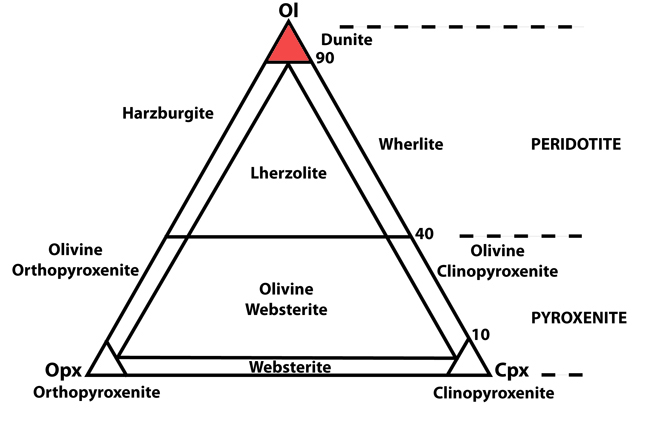Dunite
Dunite was named by the German geologist, Ferdinand von Hochstetter in 1859 after Dun Mountain near Nelson, New Zealand. Dun Mountain was given its name because of the dun colour of the underlying ultramafic rocks. This color results from surface weathering that oxidizes the iron in olivine in temperate climates (weathering in tropical climates creates a deep red soil).A dunite is an ultrabasic igneous rock dominated by essential olivine (>90% volume), often with accessory clinopyroxene, orthopyroxene, spinel, ilmenite, and magnetite. Dunite is usually coarse- to medium grained and is a peridotite. Dunite forms either as a cumulate within layered intrusions or as a residue after extraction of partial melt from a pre-existing ultrabasic rock in the mantle. Dunite cumulates and mantle rocks are found as xenoliths in a wide range of mantle derived magmas. Dunite and other peridotite rocks are considered the major constituents of the Earth's mantle above a depth of about 400 kilometers. Dunite is rarely found within continental rocks, but where it is found, it typically occurs at the base of ophiolite sequences where slabs of mantle rock from a subduction zone have been thrust onto continental crust by obduction during continental or island arc collisions (orogeny). It is also found in alpine peridotite massifs that represent slivers of sub-continental mantle exposed during collisional orogeny. Dunite typically undergoes retrograde metamorphism in near-surface environments and is altered to serpentinite and soapstone.
Dunite could be used to sequester CO2 and help mitigate global climate change via accelerated chemical rock weathering. This would involve the mining of dunite rocks in quarries followed by crushing and grinding as to create fine ground rock that would react with the atmospheric carbon dioxide. The resulting products are magnesite and silica which could be commercialized:
Mg2SiO4 (olivine) + 2CO2 = 2MgCO3 (magnesite) + SiO2 (silica)

Diagram for Ultramafic rocks. Dunite field in red
.jpg)
Dunite. From James St. John .
.jpg)
Dunite xenolith in basaltic lava from Hawaii. Width of sample 8 cm. From Sand Atlas.
Bibliography
• Cox et al. (1979): The Interpretation of Igneous Rocks, George Allen and Unwin, London.
• Howie, R. A., Zussman, J., & Deer, W. (1992). An introduction to the rock-forming minerals (p. 696). Longman.
• Le Maitre, R. W., Streckeisen, A., Zanettin, B., Le Bas, M. J., Bonin, B., Bateman, P., & Lameyre, J. (2002). Igneous rocks. A classification and glossary of terms, 2. Cambridge University Press.
• Middlemost, E. A. (1986). Magmas and magmatic rocks: an introduction to igneous petrology.
• Shelley, D. (1993). Igneous and metamorphic rocks under the microscope: classification, textures, microstructures and mineral preferred-orientations.
• Vernon, R. H. & Clarke, G. L. (2008): Principles of Metamorphic Petrology. Cambridge University Press.


.jpg)
.jpg)
.jpg)
.jpg)
.jpg)
.jpg)
.jpg)
.jpg)
.jpg)
.jpg)
.jpg)
.jpg)
.jpg)
.jpg)
.jpg)
.jpg)
.jpg)
.jpg)
.jpg)
.jpg)
.jpg)
.jpg)
.jpg)
.jpg)